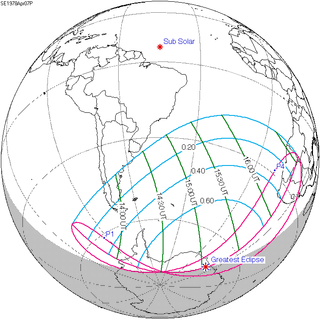Solar eclipse of April 7, 1978
Appearance
| Solar eclipse of April 7, 1978 | |
|---|---|
| Type of eclipse | |
| Nature | Partial |
| Gamma | −1.1081 |
| Magnitude | 0.7883 |
| Maximum eclipse | |
| Coordinates | 71°54′S 23°18′E / 71.9°S 23.3°E |
| Times (UTC) | |
| Greatest eclipse | 15:03:47 |
| References | |
| Saros | 148 (19 of 75) |
| Catalog # (SE5000) | 9460 |
A partial solar eclipse occurred on April 7, 1978. A solar eclipse occurs when the Moon passes between Earth and the Sun, thereby totally or partly obscuring the image of the Sun for a viewer on Earth. A partial solar eclipse occurs in the polar regions of the Earth when the center of the Moon's shadow misses the Earth.
Related eclipses
Solar eclipses of 1975-1978
This eclipse is a member of a semester series. An eclipse in a semester series of solar eclipses repeats approximately every 177 days and 4 hours (a semester) at alternating nodes of the Moon's orbit.[1]
| Solar eclipse series sets from 1975 to 1978 | ||||||
|---|---|---|---|---|---|---|
| Descending node | Ascending node | |||||
| Saros | Map | Gamma | Saros | Map | Gamma | |
| 118 | May 11, 1975 Partial |
1.0647 | 123 | November 3, 1975 Partial |
−1.0248 | |
| 128 | April 29, 1976 Annular |
0.3378 | 133 | October 23, 1976 Total |
−0.327 | |
| 138 | April 18, 1977 Annular |
−0.399 | 143 | October 12, 1977 Total |
0.3836 | |
| 148 | April 7, 1978 Partial |
−1.1081 | 153 | October 2, 1978 Partial |
1.1616 | |
References
- ^ van Gent, R.H. "Solar- and Lunar-Eclipse Predictions from Antiquity to the Present". A Catalogue of Eclipse Cycles. Utrecht University. Retrieved 6 October 2018.
External links
- Earth visibility chart and eclipse statistics Eclipse Predictions by Fred Espenak, NASA/GSFC
Wikimedia Commons has media related to Solar eclipse of 1978 April 7.




